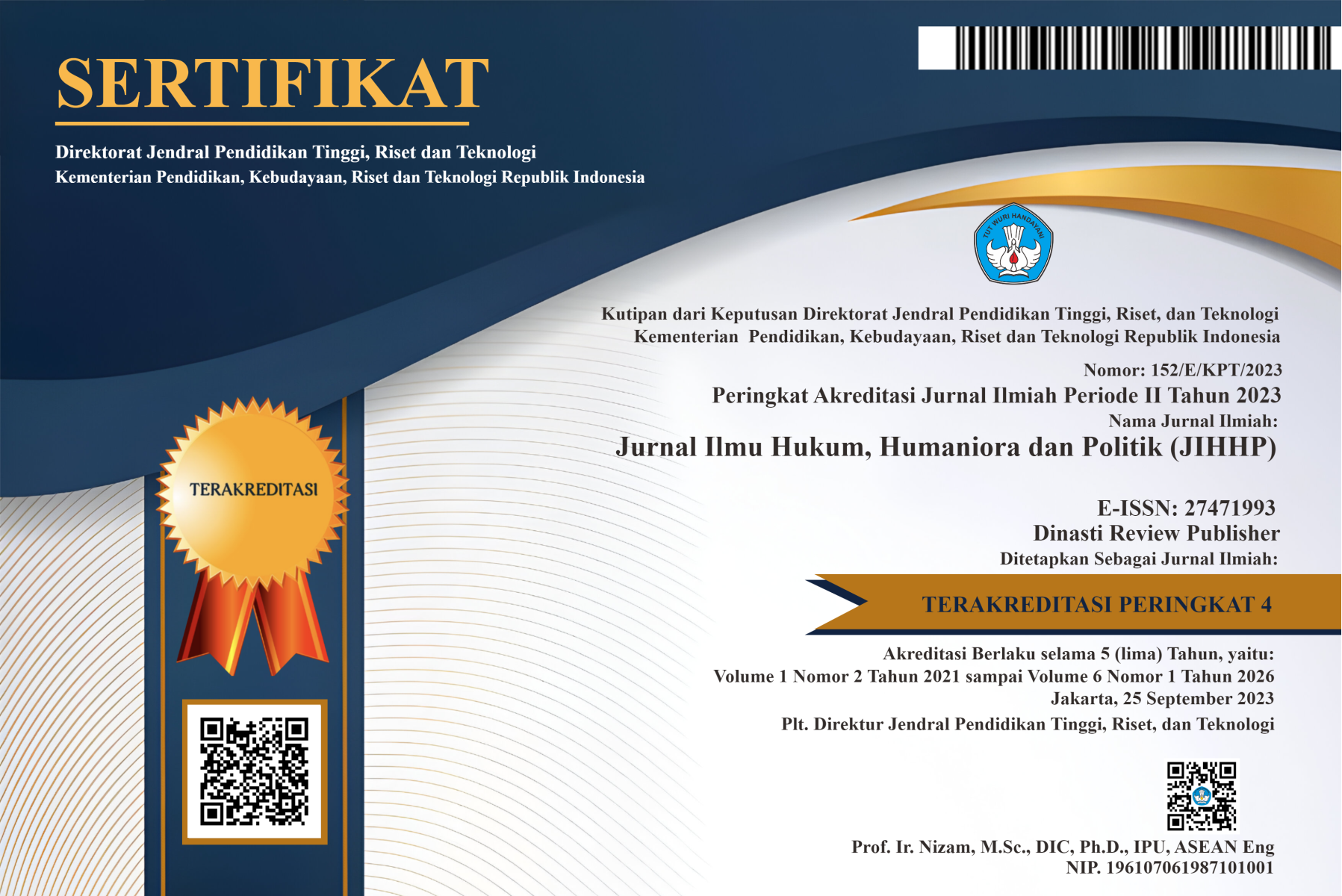Kajian Validitas Alat Ukur Sex Role Orientation Dalam Budaya Indonesia
DOI:
https://doi.org/10.38035/jihhp.v5i4.4131Keywords:
Rasch Model, Sex Role Orientation, Validitas Alat UkurAbstract
Penelitian mengenai Sex Role Orientation (SRO) di Indonesia memiliki signifikansi yang besar karena tema ini masih terbatas dalam pembahasan, terutama dalam analisis konstruk menggunakan model analisis baru, yaitu Rasch Model. SRO, yang dikembangkan oleh Brogan dan rekan-rekannya pada tahun 1976, menjadi fokus penelitian ini, yang bertujuan untuk melakukan validasi alat ukur SRO yang telah diadaptasi ke dalam bahasa Indonesia. 361 yang terdiri dari 119 orang laki-laki dan 242 perempuan. Hasil reliabilitas menggunakan Cronbach Alpha menunjukkan nilai sebesar 0,90, mengindikasikan tingkat reliabilitas yang baik pada alat ukur tersebut.Wright Map menunjukkan persebaran tingkat kesulitan item yang merata. Namun, ditemukan bahwasannya secara khusus, item nomor 34 merupakan item tersulit. Serta berdasarkan nilai mean square (MNSQ) in-fit dan outfit terdapat beberapa item yang mengalami underfit maupun overfit. berikutnya berdasarkan hasil analisa differential item functioning dengan data demografis jenis kelamin dan latar belakang pendidikan adanya beberapa item yang mengalami bias jawaban
References
Alagumalai, S., Curtis, D. D., & Hungi, N. (2005). Applied Rasch Measurement: A Book of Exemplars: papers in honour of John P. Keeves. (First Edit). Springer.
Artaria, M. D. (2016). Dasar biologis variasi jenis kelamin, gender, dan orientasi seksual. BioKultur, V(2), 157–165.
Ba?ar, F., & Demirci, N. (2018). Attitudes of nursing students toward gender roles: a cross-sectional study. Contemporary Nurse, 54(3), 333–344. https://doi.org/10.1080/10376178.2018.1504623
Bond, T. G., & Fox, C. M. (2013). Applying the Rasch Model. In Applying the Rasch Model. Routledge. https://doi.org/10.4324/9781410614575
Boone, W. J., Yale, M. S., & Staver, J. R. (2014). Rasch analysis in the human sciences. In Rasch Analysis in the Human Sciences. https://doi.org/10.1007/978-94-007-6857-4
Brogan, D., Kutner, N. G., & Scales, S. (1976). Measuring Sex-Role Orientation?: Normative Approach *. 38(1), 31–40.
Brown, C. S. (2019). Sexualized gender stereotypes predict girls’ academic self-efficacy and motivation across middle school. International Journal of Behavioral Development, 43(6), 523–529. https://doi.org/10.1177/0165025419862361
Curun, F., Taysi, E., & Orcan, F. (2017). Ambivalent sexism as a mediator for sex role orientation and gender stereotypes in romantic relationships: A study in Turkey. Interpersona, 11(1), 55–69. https://doi.org/10.5964/ijpr.v11i1.229
Hagquist, C., & Andrich, D. (2017). Recent advances in analysis of differential item functioning in health research using the Rasch model. Health and Quality of Life Outcomes, 15(1), 1–9. https://doi.org/10.1186/s12955-017-0755-0
Hawkins, I., Ratan, R., Blair, D., & Fordham, J. (2019). The Effects of Gender Role Stereotypes in Digital Learning Games on Motivation for STEM Achievement. Journal of Science Education and Technology, 28(6), 628–637. https://doi.org/10.1007/s10956-019-09792-w
Holster, T. A., & Lake, J. (2016). Guessing and the Rasch Model. Language Assessment Quarterly, 13(2), 124–141. https://doi.org/10.1080/15434303.2016.1160096
Hulin, C. L., Drasgow, F., & Komocar, J. (1982). Applications of item response theory to analysis of attitude scale translations. Journal of Applied Psychology, 67(6), 818–825. https://doi.org/10.1037/0021-9010.67.6.818
Kerr, B. A., & Multon, K. D. (2015). The development of gender identity, gender roles, and gender relations in gifted students. Journal of Counseling and Development, 93(2), 183–191. https://doi.org/10.1002/j.1556-6676.2015.00194.x
Lam, C. B., Stanik, C., & McHale, S. M. (2017). The development and correlates of gender role attitudes in African American youth. British Journal of Developmental Psychology, 35(3), 406–419. https://doi.org/10.1111/bjdp.12182
Levesque, R. J. R. (2011). Sex Roles and Gender Roles. Encyclopedia of Adolescence, 2622–2623. https://doi.org/10.1007/978-1-4419-1695-2_602
Mgbemena, N., Jones, A., & Leicht, A. (2022). Internet Journal of Allied Health Sciences and Practice Assessment of Inter-Instrument Reliability for Dominant Handgrip Dynamometry and Spirometry Assessment of Inter-Instrument Reliability for Dominant Handgrip Dynamometry. 20(4).
Nasit, T., & Desai, M. (2019). Sex-role orientation as the moderator of relationship between organizational role stress and psychological health among working women. Indian Journal of Community Psychology, 10(1), 154–161. http://ovidsp.ovid.com/ovidweb.cgi?T=JS&CSC=Y&NEWS=N&PAGE=fulltext&D=psyc11&AN=2014-08772-014%5Cnhttp://bf4dv7zn3u.search.serialssolutions.com.myaccess.library.utoronto.ca/?url_ver=Z39.88-2004&rft_val_fmt=info:ofi/fmt:kev:mtx:journal&rfr_id=info:sid/Ovid:
Sumintono, B., & Widhiarso, W. (2014). Aplikasi Model Rasch untuk Penelitian Ilmu-Ilmu Sosial (B. Trim (ed.); Issue November). Trim Komunikata Publishing House.
Tamura, A., Hidaka, Y., Ikeda, H., & Hamaura, N. (2023). An Estimation Method for Bias Error of Measurements by Utilizing Process Data, An Incidence Matrix and a Reference Instrument for Data Validation and Reconciliation. Journal of Nuclear Engineering and Radiation Science, 9(4).
Ward, L. M., & Grower, P. (2020). Media and the Development of Gender Role Stereotypes. Annual Review of Developmental Psychology, 2(1), 177–199. https://doi.org/10.1146/annurev-devpsych-051120-010630
Downloads
Published
How to Cite
Issue
Section
License
Copyright (c) 2025 Annisah Nurul Azizah, Ananta Yudiarso

This work is licensed under a Creative Commons Attribution 4.0 International License.
Hak cipta :
Penulis yang mempublikasikan manuskripnya di jurnal ini menyetujui ketentuan berikut:
- Hak cipta pada setiap artikel adalah milik penulis.
- Penulis mengakui bahwa Jurnal Ilmu Hukum, Humaniora dan Politik (JIHHP) berhak menjadi yang pertama menerbitkan dengan lisensi Creative Commons Attribution 4.0 International (Attribution 4.0 International CC BY 4.0) .
- Penulis dapat mengirimkan artikel secara terpisah, mengatur distribusi non-eksklusif manuskrip yang telah diterbitkan dalam jurnal ini ke versi lain (misalnya, dikirim ke repositori institusi penulis, publikasi ke dalam buku, dll.), dengan mengakui bahwa manuskrip telah diterbitkan pertama kali di JIHHP.















































